As an artist, learning how to make green (and the variations you need), can seem like an intricate puzzle. However, once you understand the foundation of how to make the color green, then it just becomes a matter of mixing often and gaining familiarity with what colors do what!
To help you gain a better understanding of what colors do what when mixed together. This article, contains color mixing charts for how to make green that will allow you see clearly the specific color mixtures for making different shades. However, before we take a look at the first of the green color charts, let’s quickly go over a bit of important color theory essentials!
Green Color Theory Essentials
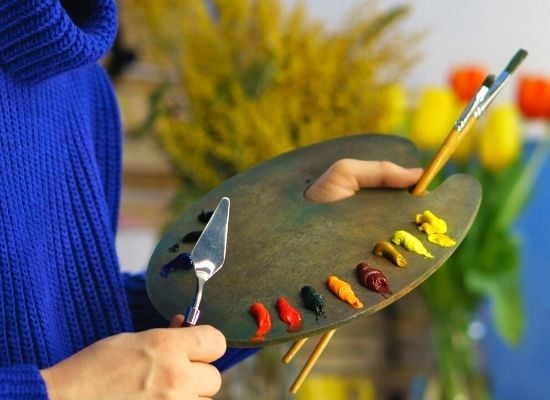
Green is a secondary color and being so, can be created by mixing two of the three primary colors together. However, though it’s important to understand the foundation of what colors make green. Learning how to make greens, particularly for your art, is about being able to utilize the full spectrum of colors available. And by understanding what other color groupings (such as complementary colors) can do for you, the richer your color mixtures will become!
How to Make Green: Mixing Two Colors
Blue and yellow mixed together will make green. However, depending on the yellow and blue you mix together, will determine the kind of green color mixture you will create. There’s a whole spectrum of greens waiting to be explored through different color combos.

Mixing Green Video Demonstration
Learn how to make green colors that are infused with the warmth of a warm yellow in this demonstration. Click the play button (below) now, to watch the color mixing video guide!
Mixing Greens with Different Yellows and Blues
In the diagram directly below, you can see that the yellow colors are all the same but I use a different shade of blue for each color mixture. I simply want to demonstrate, that although the basic formula of how to mix green color is quite simple – the use of different blues and yellows will make different greens!

The blue colors listed on the chart above; ultramarine blue, cobalt blue, RGH blue and pthalo blue, all end up creating slightly different shades of green when mixed with cadmium yellow.
One could also use a different type of yellow such as cadmium lemon, yellow ochre, or naples yellow. However, there is no need to get carried away with different types of blues and yellows to make green at first. As long as you have all the essential paint colors necessary you will be set to mix a large range of colors.
How to Make the Color Green Muted
When learning how to create the color green, it’s valuable to understand how to achieve different shades of muted green colors. Let me guide you through the process!
Mixing Green and Red Together
You can create a muted shade of green by mixing red and green together. However, remember as we talked about when mixing blue and yellow–that different reds make different muted shades of green.

The initial green colors in the chart above, are the same as the ones we created in the first color chart. Except now we are mixing the greens we created with cadmium red.
You can see a slight difference between the shades of green that red and green make when mixed together, when compared to the shades of green on the left. The shades on the right are much warmer and not as bright of a green.
Complementary Color’s Affect on Greens
Whenever you mix a color with its complementary color it will make it less of its own color. For example, whenever greens are mixed with a red, these two colors mixed make green a lesser shade of itself. The opposite is also true when it comes to mixing a red color. When you have red and green mixed together, the red will be a lesser shade of red.

To unlock and get a better understanding of how colors work together, make sure to spend some time learning about the artist’s color wheel. Along with this complementary color wheel seen above, there are multiple variations of the color wheel that can help deepen your ability to mix colors.
How to Make Light Green Colors
It is important to know how to mix lighter greens for the situations in which you need them!
Now, mixing green and white together is possibly the easiest (and commonly thought of) way to make green lighter. However, you do not want to limit yourself to only using white painting to lighten a green. If you do, your mixture might start to look a little pasty and uninteresting-as paintings that are mixed exclusively with white often look.

How to Lighten Green (Green and Yellow Mixed)
As you can see in rows one and two below, Cadmium yellow and green mixed together makes a lighter shade of green. While cadmium lemon makes a slightly darker-light shade of green.

Both of the yellows in the chart above, are great options for creating lighter shades of green. As a bonus, yellow ochre is another great color option, when experimenting with green and yellow mixed together. Other options: Naples yellow, cadmium green light.
How to Make a Dark Green Colors
There are various instances where knowing how to create rich dark green colors becomes handy. Avoid relying solely on black to darken your greens, as it can make all shades of green appear identical. Instead, spice things up by experimenting with color combinations to discover how to achieve a darker green hue. So, let’s mix it up and create some captivating shades of green!
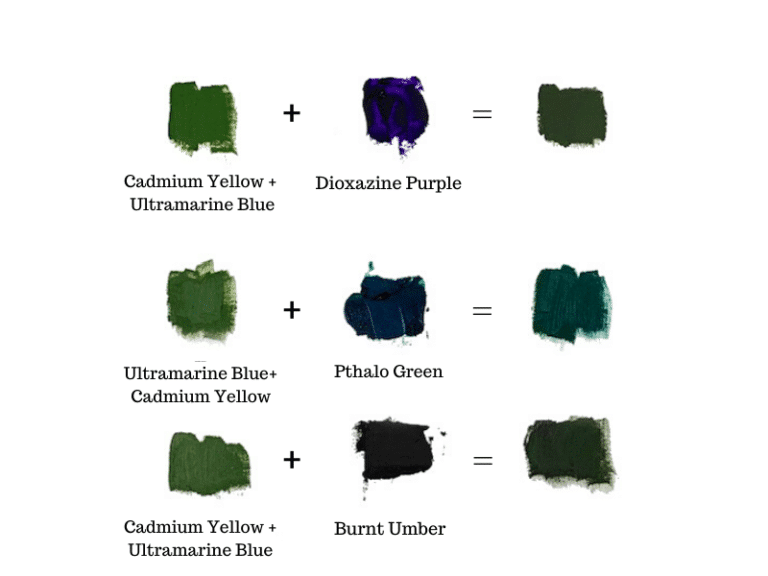
Dark Green Shades, Using Another Dark Green

In addition, pthalo green will darken your green quickly. The only downside is that it can be a very saturated color. So, you might need to mute the color a little bit with alizarin crimson.
How to Make Green Darker Mixing Two Colors

Lastly, burnt umber is also a great option for how to make dark green color darker by mixing two colors. Though, it will probably be more of an earthy green since your green is being mixed with a brown. Other options: ultramarine blue, black, van dyck brown
Mixing Warm Green (Color Charts)
Temperature is important to all color mixing especially when it comes to greens. For example, when painting a landscape you want to be able to tell the viewer if it is a cold winter day or a warm sunny landscape. This is where paying attention to temperature in color mixing plays a role!
In the color chart below, I show a few options of what two colors make green warmer when mixed together. Adding some cadmium orange to your green is a great way to create a warm green color. Yellow ochre will also make your green warmer, but will also make it more of an ‘earthy green’ as yellow ochre is an earth tone color.

How to Make the Color Green Cool in Temperature
At the top of this color chart is provence violet bluish – probably one of my favorite colors to mix green with. The result of these two colors mixed make green a subtle cooler green color. Dioxazine purple is another good option to make your greens cooler – especially if you need to darken your green at the same time.

Making Green Cooler Using Different Types of Green
Veronese green is another favorite of mine to make a cool green with. It makes green cooler, while also creating a more saturated color. So, if you need a little more punch in your green – this is a good color!

Also, pthalo green is quite similar to veronese in that it can provide a lot of saturation to your green. In fact, it will provide even more saturation than veronese green! Also, it will darken your green at the same time.

Other options: You can also use blue colors to make green cooler.
Examples of How to Mix Greens for Your Painting
Here are some real life examples of green colors mixed together within a painting. Each painting is an example of how use different kinds of greens for different situations.
Mixing Green Leaves of a Rose
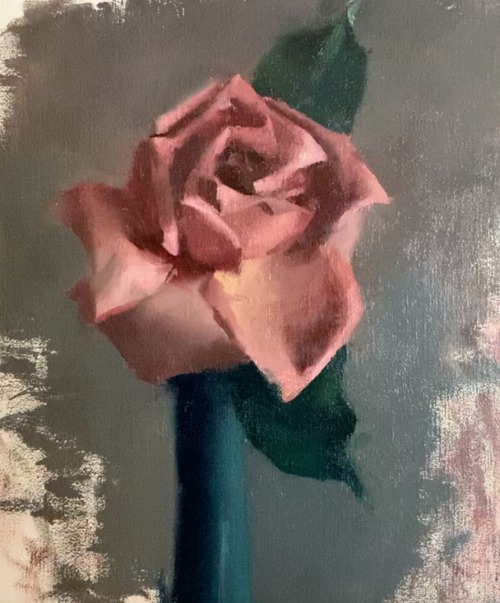
Painting Various Green Colors of Landscape

Whether creating shades of green for a still life of a rose, or a landscape painting, you will see that there is never really a simple formula for how to make green. Getting a certain color can take a lot of experimenting with mixing different colors.
Stormy Day Landscape Painting Example

This painting has much darker greens than the other two paintings shown above. Notice that many of the colors used for the mixtures in this painting are dark.
Ideas for Working on How to Mix Different Greens
Get outside and practice painting the shades of green in the landscape around you, using the mixing principles outlined above. However, also be sure to experiment with different color combinations until you get the precise green you are looking for.
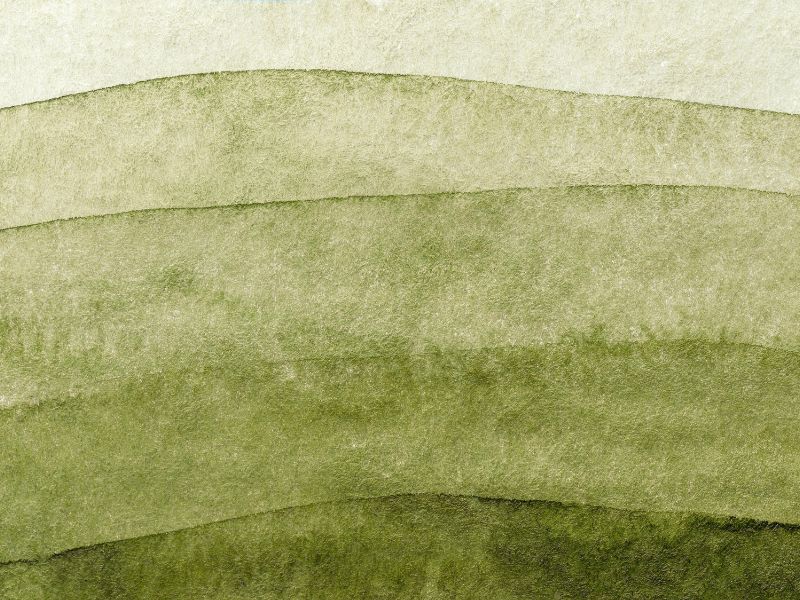
As you can see, how to make green is a world unto itself. There are endless ways of how to make different shades of green. The sky is the limit!
It is exciting experimenting with different color combinations you can mix together for your paintings. So look around at the different shades of green that are possible for inspiration.
And above everything else, have fun and challenge yourself as you work on mixing colors and how to make the color green!
Additional Resources for How to Make Green
Understanding the nuances of color mixing is not just a useful skill—it’s an essential one for any artist (or color mixing enthusiast). If you’re eager to learn more about how to make the color green, as well as many other colors, be sure to take a look at my color mixing resources available below!
📕 Color Mixing Master Guide (PDF Ebook)

Take the Uncertainty out of mixing colors with my 150+ page ebook (in PDF format). The Color Mixing Master Guide, is chock full of valuable information, that will help demystify color mixing for artists! You will find in-depth color mixing charts, that will help guide you with any color mixing problem you may have. Learn more≫
🎨 Color Mixing MasterClass Course

Mixing colors is one of the most important and difficult skills to master. Enrolling in my Color Mixing MasterClass Course, will help you gain the fundamental techniques (and visual guidance) you need, for mastering the art of mixing any color you desire! Learn how to mix colors with ease in the Color Mixing MasterClass! Learn more≫
Want to remember this? Save the Green Color Mixing Charts to your favorite Pinterest board!





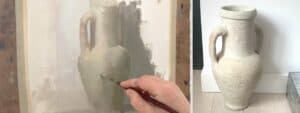


32 thoughts on “How to Make the Color Green (Color Mixing Charts)”
Thank you for this. I am now spending a lot of time doing colour mixing charts before starting my next painting!!
You are so welcome! Glad this is helpful 🙂
I got my few questions answers here , thank you so much for your helpful and useful content
Glad to hear that, you are so welcome!
This color mixing master guide looks great and I couldn’t resist the purchase, just based on looking thru your instructions for making green. Clear, concise, and very comprehensive, with all the necessary visuals. Perfect for a beginner, whilst also offering tremendous potential for growth in deep appreciation for the complexity of this science and brilliant art. Absolutely fabulous! 🎨🎨🎨
Hi Janet, I am so happy to hear how much you are enjoying the color mixing master guide! That is wonderful – thank you for sharing that! I appreciate it very much. Wish you lots of happy painting and much joy with the color mixing process.
Hola. Muy agradecida de haber encontrado tanta información útil y tan bien explicada. Estoy intentando aprender a pintar en acuarelas y también con pinturas acrilicas para proyectos para mi hogar. He buscado mucho pero hasta hoy no lo había logrado. Muchas bendicionescdesde Venezuela.
I am so glad that the information here is helpful! Thank you so much for sharing 🙂
Thank you so much for the thourough explanation.
You are so welcome Maria!
I just want to THANK you for this article, with so much details and information, it is the best that I read until now.
I wish you the best.
Maha
HI Maha, I am happy to hear that! You are so welcome, really glad this article is helpful for you 🙂
Elisabeth, your articles are JUST THE TICKET!!!! Very thorough and easy to understand, with plenty of “example” pictures to make it real. Thank you so much. Could you do one on translating colors into “tones”? I love how certain artists will paint a garden scene, for example, with a garden shed or house wall in it, and the wall might be a shade of violet, the sunlit spots a shade of peach….I don’t understand how to successfully translate colors into tones! You would know!
Hi Robin, So happy to hear that – thank you for sharing! Am glad to hear that this article was helpful and easy to understand. An article on translating colors into tones would be very good as it is a very important topic! I have one related to it already here – https://artstudiolife.com/painting-with-color-and-light-color-shading/ – that might be helpful! I work tonally with all of my paintings so watching some of my video tutorials on youtube might be helpful as well as I talk about how to start out in a strong tonal manner using color. Hope that helps!! 🙂
What is RGH blue please?
Apologies for my delayed reply! RGH blue is similar to cerulean blue 🙂
Your site is exactly what I was looking for. Thank you for doing this!
So glad to hear, you are very welcome!
Very well explained.
Thanks so much.
One question.. is cadmium yellow the basic yellow to use? I somehow have always used lemon yellow. Does that change the green colour created?
Yes! Cadmium yellow is basic yellow to use. Lemon yellow will create more of a lighter (and cooler) yellow color than regular cadmium yellow. If you are just using regular lemon yellow as opposed to cadmium lemon yellow than the color will probably not be as strong. I hope that helps!
Thank you for such important guide to all of us selftaught artist..we learn from you a lot….such a wonderful teaching.
…thank you so much.
You are welcome! I am very glad to hear that the information on the website is helpful!
What proportions needed to make one qt. Using yellow and blue.
I would use equal amounts of each. Whichever amount you are creating I would use an equal amount of blue and an equal amount of yellow. Since 4 cups equals 1 quart – I would mix two cups of blue with two cups of yellow. However, if you want to create more of a yellowy green than I would mix a little more yellow.
Thank You. Just the article I’ve been needing.
Glad to hear Patricia!
Thank you! Most comprehensive color mixing advice I’v seen.
I am glad to hear that it was helpful!
I’ve seen a few articles about greens, this one takes the cake.
I could probably do a totally green painting now.
This was an eye opener.
Thanks heaps !!
Dave M 😎🇦🇺
Thank you Dave! I am pleased to hear that this mixing greens article is helpful!
Never new there were so many greens in all my life and how to use them thank u very much, sort of a beggener.
Hi Linda,
Glad you came across across the article! Yes, is are a world of greens!